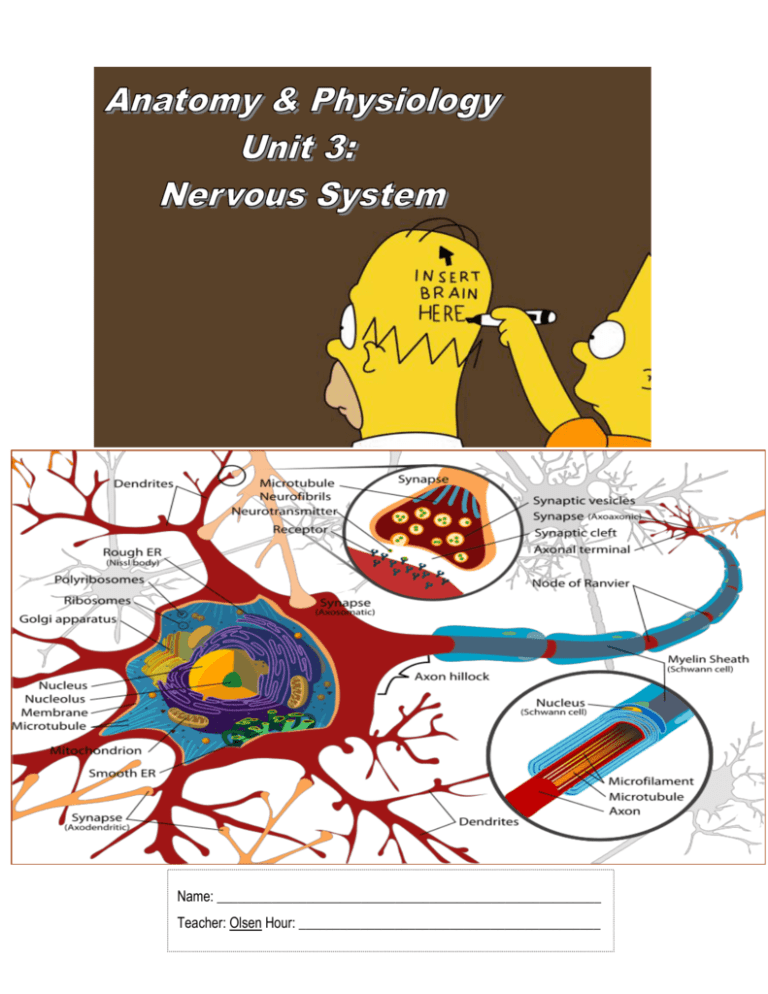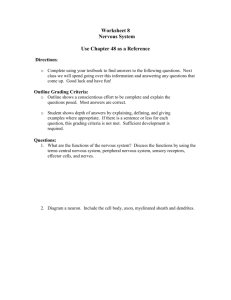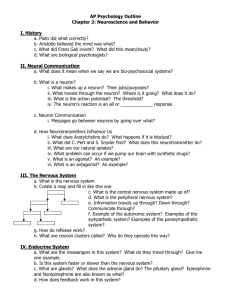The Nervous System
advertisement

Name: ________________________________________________________ Teacher: Olsen Hour: ____________________________________________ 41 The Nervous System: Part 1 Textbook p216-225 In all exercises, quizzes and tests in this class, always answer in your own words. That is the only way that you can show that you understand what you are saying. Also, make it a habit to answer in full sentences whenever it is appropriate for the question. You will also be responsible for the vocabulary words listed on p239. 1. What structures make up the central nervous system? 2. What structures make up the peripheral nervous system? 3. What are neurons and neuroglia? How are their functions different from each other? 4. What are the functions of the three types of neurons? a. Sensory neurons b. Interneurons c. Motor neurons 5. Be able to identify all of the parts of a neuron as shown in figure 11.2 on page 218. 6. How do dendrites and axons differ in their functions? 7. Neurons are like muscle cells in that they are excitable cells. What does that mean? 8. What is meant by the term "resting membrane potential" in a neuron? 9. Why is resting membrane potential generally a negative number (about -70 mV in neurons)? 10. In setting up resting membrane potential: a. What is the role of K/Na pumps? b. What is the importance of passive Na and K channels? c. Why do neurons constantly need to use up ATP, even when not sending signals? 11. What is meant by the term "action potential" and what does it have to do with the signals sent by neurons? 12. What is a graded potential? What must happen before a graded potential leads to an action potential? 42 13. What does it mean to say action potentials are "all-or-nothing" events? 14. What does it meant to say a stimulus is "sub-threshold"? 15. What is a "voltage-gated channel"? 16. Describe fully and in your own words the movement of ions and the channels involved during the course of an action potential. 17. In one or two good sentences, describe how nervous impulses are transmitted from one neuron to another, using these terms: Synapse, Neurotransmitter, Presynaptic membrane, Postsynaptic membrane, Receptors 18. How can a neurotransmitter like acetylcholine excite some cells but inhibit other cells? 19. How do EPSP's and IPSP's interact during "synaptic integration"? 20. What is meant by "spatial summation" and "temporal summation"? 21. What is the importance of enzymes like acetylcholinesterase, which break down neurotransmitters? 22. What is the importance of the myelin sheath in many of the axons of the peripheral nervous system? 23. Describe a basic reflex arc, including the three types of neurons generally involved. 43 Membrane Potentials To answer questions 1-7, consider the processes involved in setting up resting potential in a typical neuron. Look back at the previous pages in the book and consider PhysioEx when answering these questions. 1. What is the role of Na/K pumps in setting up resting potential? 2. What would happen to resting potential if a chemical "poison" blocked the Na/K pumps? Could such a cell undergo action potential? 3. What is the role of "leak" channels in setting up resting potentials? 4. What would happen to resting potential if a chemical opened more K channels than normal? 5. What would happen to resting potential if a normal cell were bathed in a solution with higher than normal Na ion concentration? 6. What would happen to resting potential if a normal cell were bathed in a solution with higher than normal K ion concentration? 7. Which external ion concentration would have a stronger effect on resting potential, Na ion or K ion? Explain your answer. 44 The diagram below shows a typical action potential for a neuron. 8. At the place marked #6, what is happening to change membrane potential. Be specific about channels and ions involved. 9. Same question regarding the section labeled #2. 10. Same question regarding the section labeled #3 11. How would this graph be different if voltage-gated Na channels were poisoned by a chemical that made them unable to open? Draw the new graph and explain in words. 12. How would this graph be different if voltage-gated K channels were blocked by a chemical poison that made them unable to open? Draw the new graph and explain. 13. How would this graph be different if external Na ion concentration were raised significantly? Draw the new graph and explain. 14. How would this graph be different if external K ion concentration were raised? Draw the new graph and explain. Type of Protein Channel & Picture + K Leak Channels Extracellular K+ Type of Transport Primary Location(s) in a Neuron All over the cell membrane Na+ K+ Intracellular Na+ Extracellular Leak Channels Na+ Na+/K+ pumps Intracellular Extracellular Intracellular Facilitated Diffusion (Hi Lo) No ATP required When it Opens When it Closes Usually Open Usually Never 45 Other Descriptions or Notes Process(es) It is Involved In Maintaining resting potential EK = -90mV K+ always leaks out of the cell leaving the membrane neg- inside. 46 K+ Voltage-Gated Channels Extracellular Intracellular Na+ Voltage-Gated Channels Extracellular Intracellular Ca+2 Voltage-Gated Channels Extracellular Intracellular 47 The Nervous System: Part 2 Textbook p226-239 1. The nervous system is often divided into two divisions by location, the central and peripheral nervous system, but it is also often divided into two divisions by functions: the somatic division and the autonomic division. Describe the general location and functions of these two divisions. 2. The autonomic nervous system is also divided into two groups according to function: the sympathetic and parasympathetic nerves. The two groups of nerves often work antagonistically. That is, the actions of one group oppose the actions of the other. Describe in general terms the function of the two groups. 3. What sorts of responses are included in what is known as “fight or flight” response? 4. What is meant by the terms “white matter” and “gray matter”? 5. What are the “meninges” and what are their functions? 6. Learn the regions of the brain and their functions as described in Table 11.2 on page 230. 7. How is it possible for two nerves, one sympathetic and one parasympathetic, connected to the same organ, (the stomach for example,) to have exactly opposite effects on the organ? (This one will require some thought- I don't think the answer is expressed in the book.) 8. Why is it sometimes effective in cases of severe epilepsy to cut the corpus collosum? 9. What is the physiological basis for short-term and long-term memory? 10. Describe how each of these drugs causes its effect: Nicotine, amphetamines, cocaine, and alcohol 48 The Human Brain Fill in the vacant lines with the appropriate part of the brain. _________________ __ _________________ __ _________________ __ _________________ __ _____________ __ _________________ __ _________________ __ _________________ __ _________________ __ _____ _____ _____ ____ _________________ __ _________________ __ _________________ __ _________________ __ 49 50 51 52 53 54 55 56 57 Nervous System Review 1. A neuron that stimulates a muscle in your arm is part of the central/peripheral (circle one) nervous system 2. Can neuroglia undergo action potentials? 3. The type of cell that carries nerve impulses in the nervous system is the ________________________. 4. The type of cell that nourishes, supports, and influences the activity of the neurons is the ________________. 5. The part of the neuron that brings in the signals to the neuron cell body is the ________________________. 6. The part of the neuron that carries the signals away from the cell body is called the ____________________. 7. The part of the neuron that contains the nucleus is the _________________________. 8. Define the following terms: a. Action Potential b. Threshold Potential c. Resting Potential d. Graded Potential Use these choices to answer questions 9-12: A. Na/K pumps B. Na leak channels C. K leak channels 9. Which of the above require ATP? 10. Which of the above creates the difference in concentration of Na and K ions between the inside and the outside of the neuron. 11. Which of the above is most responsible for the difference in charge between inside and outside of a neuron at rest (resting potential)? 12. Which of the above perform facilitated diffusion? Use these choices to answer questions 13-15 A. Sensory neurons B. Interneurons C. Motor neurons 13. All of the neurons in the brain are this type. 14. This is the type of neuron that would make your heart speed up. 15. This is the type of neuron that tells you that you are hungry. 58 16. Within a neuron, what is the function of the axon? 17. What would happen to the resting potential of a neuron if it ran out of ATP? 18. When a neuron receives an excitatory stimulus, what causes the membrane to depolarize? 19. All stimuli cause neurons to depolarize. True or False 20. When threshold potential is reached, voltage-gated Na channels open up. True or False 21. When voltage-gated K channels open up, the membrane potential goes down. True or False 22. Graded potentials always cause action potential. True or False 23. Normally, once threshold potential is reached, a full action potential will follow. True or False Use the graph below to answer questions 24-27: 24. In the portion of the action potential above labeled 2, what channels are open? 25. In the portion of the action potential above labeled 3, what channels are open? 26. How would this graph be different if a drug blocked the voltage gated K channels? 27. How would this graph be different if the cell were bathing in a solution with more than normal Na ion concentration? 28. What is the role of neurotransmitters and receptors in carrying signals from nerve to nerve? 29. Why is it important that enzymes like acetylcholinesterase remove neurotransmitters from synapses? 59 30. What types of neurons are involved in a reflex arc (in proper order). Choices for questions 31-35: A. Somatic B. Autonomic C. Sympathetic D. Parasympathetic 31. This portion of the nervous system includes nerves that stimulate the skeletal muscles. 32. Nerves of this portion of the nervous system get the internal organs of body ready for action, the so-called “fight or flight” reflex. 33. Sensory nerves in the skin would be part of this portion of the nervous system. 34. This portion of the nervous system increases digestive system activity. 35. This system includes both sympathetic and parasympathetic nerves. 36. Why is the myelin sheath important to the proper functioning of the nervous system? 37. How does nicotine affect the nervous system? 38. What is the limbic system and what parts of the brain are included? 39. On figure 11.18, identify the following structures and their functions: a. Cerebrum b. Cerebellum c. Pons d. Medulla Oblongata e. Hypothalamus f. Thalamus 40. The membranes that cover the brain and spinal cord are called ______________. 41. The main function of these membranes is: 42. What type of stimuli can cause action potentials in neurons? 43. What is the effect of lidocaine, ether, and curare on action potentials? 60 44. It is possible to stimulate a neuron electrically and not have an action potential occur. Give as many reasons as you can that would explain how this could happen. 45. Respond to the statement: “Being in love is like being on drugs.” 46. Scientifically, why should someone take a practice test before taking the real test? 47. Respond to the statement: “Men and women respond to stress in similar ways.”









